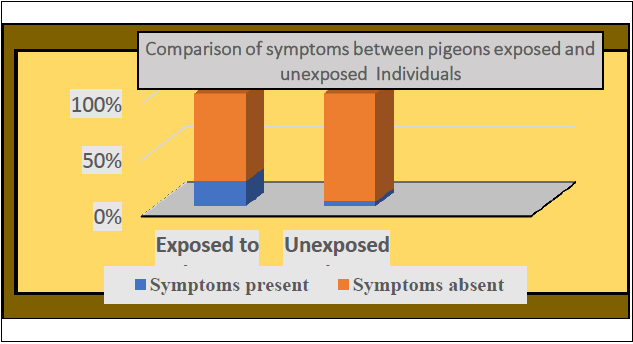The health risks of Columba livia Infestation: A public Health Concern of Thane District, Maharashtra
DOI:
https://doi.org/10.26438/ijsrbs.v12i3.676Keywords:
Columba livia, Zoonotic disease, Respiratory disorder, Hypersensitivity pneumonitis, Human populationAbstract
Columba livia, commonly known as the domestic pigeon, is a ubiquitous bird species found throughout the country. With a long history of association with humans, pigeons have been domesticated for various purposes, including food, sports, research, and as ornamental birds. However, the close association between pigeons and humans has a darker side. As pigeons come into contact with human populations, they pose a significant risk to public health. These birds can carry a variety of pathogens, including bacteria, viruses, and fungi, which can cause diseases in humans. The proximity of pigeons to human settlements, coupled with their ability to thrive in urban environments, makes them a potential reservoir for zoonotic diseases. The present study deals with the health issues when get exposed to pigeon.
References
D. Haag-Wackernagel, Moch H, “Health hazards posed by feral pigeons,” Journal of Infection, vol.48 issue 4, pp307-313, 2004.
P. D. Curtis, T. P. Sullivan, & D. S. Sullivan, “Biological control of feral pigeons: A review,” Wildlife Society Bulletin, Vol.30, Issue.2, pp.442-452, 2002.
G. Gallo, L. Fagioli, F. DiGiovanni, “Yeast flora of feral pigeons in rural habitats,” Mycopathologia, Vol.106, Issue.2, pp.131-135, 1989.
J.N. Fink, H.G. Ortega, H.Y. Reynolds, Y.F. Cormier, L.L. Fan, T.J. Franks, K. Kreiss, S. Kunkel, D. Lynch, S. Quirce, C. Rose, R.P. Schleimer, M.R. Schuyler, M. Selman, D. Trout, Y. Yoshizawa, “Needs and opportunities for research in hypersensitivity pneumonitis,” American Journal of Respiratory and Critical Care Medicine, Vol.171, Issue.7, pp.792-798, 2005. doi: 10.1164/rccm.200409-1205WS.
A. K. Sinha, “Hypersensitivity pneumonitis in north Indian population,” European Respiratory Journal, 54(suppl 63) 2019, PA4737.
G. Ballarini, G. Giannatiempo, P. Marziani, “Damage to buildings caused by feral pigeons,” International Biodeterioration, vol. 25(2-4), pp 249-254, 1989.
D. Pimental, L. Lach, R. Zuniga, D. Morrison, “Environmental and economic costs of nonindigenous species in the United States,” Bioscience, vol. 50 issue1, pp 53-65, 2000.
D. Chandra, S. V. Cherian, “Hypersensitivity Pneumonitis,” StatPearls. Treasure Island (FL): StatPearls Publishing 2023. PMID: 29763093.
F. Morell, A. Roger, L. Reyes, M. J. Cruz, C. Murio, X. Muñoz, Bird fancier's lung: a series of 86 patients. Medicine (Baltimore), vol 87, issue 2, pp 110-130, 2008. doi: 10.1097/MD.0b013e31816d1dda. PMID: 18344808.
S. Singh, B. F. Collins, M. Bairwa, J. M. Jyotsna, T. Deepak, N. Singh, J. K. Samaria, D. K. Mangal, V. Singh, G. Raghu, “Hypersensitivity pneumonitis and its correlation with ambient air pollution in urban India,” European Respiratory Journal, vol. 53, issue 2, 2019, 1801563.
M. Mukthar, M. Hasan, M. Rashed Hasnath, Global prevalence of zoonotic pathogens from pigeon birds: A systematic review and meta-analysis. Heliyon, Vol. 8 issue 6, 2022, e09732.
Y. Lacasse, M. Selman, U. Costabel, J.C. Dalphin, M. Ando, F. Morell, R. Erkinjuntti-Pekkanen, N. Muller, T. V. Colby, M. Schuyler, Y. Cormier, “Clinical diagnosis of hypersensitivity pneumonitis,” American Journal of Respiratory and Critical Care Medicine, Vol. 168 issue 8, pp 952-958, 2003, doi: 10.1164/rccm.200301-137OC.
Times of India. (assessed on 19/03/25). Residents rope in TMC to tackle pigeon issue near meadows.
Indian Express. (assessed on 19/03/25). Explained: Why feeding pigeons can be harmful to humans.
C. Cramer, V. Schlünssen, E. Bendstrup, Z. A. Stokholm, J. M. Vestergaard, M. Frydenberg, H. A. Kolstad, “Risk of hypersensitivity pneumonitis and interstitial lung diseases among pigeon breeders,” European Respiratory Journal, Vol.48 issue 3, pp 818-825, 2016, doi: 10.1183/13993003.00376-2016.

Downloads
Published
How to Cite
Issue
Section
License
Copyright (c) 2025 Sanjay B. Salunke, Shahjahan A. Shaikh

This work is licensed under a Creative Commons Attribution 4.0 International License.
Authors contributing to this journal agree to publish their articles under the Creative Commons Attribution 4.0 International License, allowing third parties to share their work (copy, distribute, transmit) and to adapt it, under the condition that the authors are given credit and that in the event of reuse or distribution, the terms of this license are made clear.






